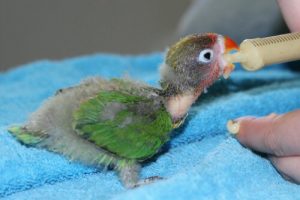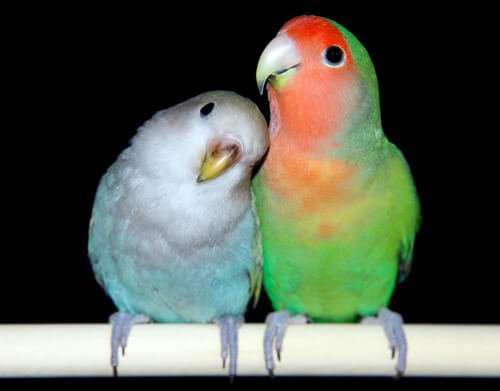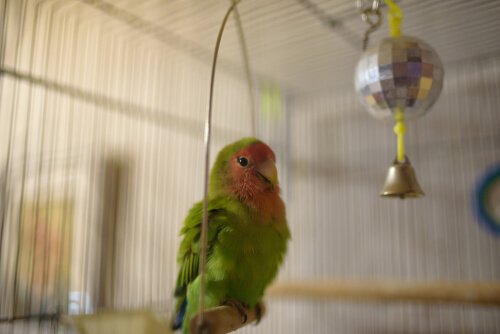Raising Lovebirds: What to Keep in Mind

The Agapornis is an exotic species from tropical Africa (Tanzania, Kenya, and Madagascar) and they are called lovebirds due to their strong bonds with their partners. These animals are very delicate creatures, so don’t take raising them lightly. Therefore, if you plan on raising them, then here are some important things to keep in mind.
There are different types of lovebirds. The most common are Fischer’s lovebird, the yellow-collared lovebird, and the rosy-faced lovebird. They usually grow up to 5-6 inches long, depending on the species. Their feathers have all kinds of beautiful color like green, red, orange, blue, and violet.
Before you start raising lovebirds
Don’t rush into anything without thinking it over. Think about whether you really have space and budget to take on this responsibility. Those two things are truly important when it comes to caring for these little birds.
It’s also important to think about what you’re going to do with the lovebird chicks. Will they stay with you? Do you have family or friends who might want them? Will they bother your neighbors? Keep in mind that 5-6 chicks come from each pregnancy.
Getting prepared
Once you’ve thought about all those aspects, find your two lovebirds that are from the same species. A cross between two different species almost always results in the death of the chicks. Some might survive, but they’re sterile for life.
Make sure one is male and the other female because it can be hard to spot the difference because their naturally affectionate behavior might point you in the wrong direction. It’s best to do a DNA test to figure out their sex, with one feather from their wings.
Male lovebirds court females by giving them food. After mating, it can take three to ten days later for the female to lay her first egg. Once that time has passed, she’ll lay one or more egg a day until she reaches a total of 4-6.
Never do this with a blood-related couple. Mother and father both give 50% of their genes to a child, so if they’re blood-related, most of their genes will be the same. That generally causes deformations, premature deaths, and all kinds of other awful things.

You need to make sure the lovebirds eat properly. Factory feed, seeds, and fresh fruits and vegetables are an essential part of their diet. You can also add calcium blocks and baby paste.
Making an ideal space
Get a big cage that’s big enough that you can fit a wooden nest and some toys to keep the lovebirds entertained. Place the cage in a location that doesn’t have any breeze or sudden changes in temperature. It should also have a lot of natural lighting, and be somewhere you know that nothing will bother them.
As mentioned before, the nest should be made out of wood. The nest should be no less than 9 inches (wide), 5.5 inches (long), and 6 inches (tall). Likewise, you should attach it to the cage horizontally. The lovebirds will need palms leaves to fill up their nest. They’ll do the filling by themselves, they know how to create a warm, comfortable place for incubation.
Place a small tub of water as soon you put the nest in the cage because Lovebirds have to add water to the eggs occasionally to make sure they hatch without any problems.
Egg laying and raising chicks
Females generally lay eggs every other day. They’ll lay between 4-6, and males usually feed females during this time, due to the amount of time she incubates the eggs.
The initial process is very delicate. You have to watch over the female, and as soon as you see the first egg you have to watch her lay the rest, to make sure she doesn’t hold any in. If she has a swollen abdomen and hasn’t laid an egg for 48 hours, go straight to an exotic pet veterinarian.

As long as the parents allow you to, check on the eggs often to make sure the chicks will be okay. If one breaks at all, it’s better to take it out and prevent it from rotting in the nest.
Incubation starts with the first egg. The female rarely leaves the nest until it’s over. Make sure she has a clean tub of fresh water because she might want to wash off after she’s done. Plus, as mentioned before, the eggs need some of that water to hatch properly.
Lovebird chicks hatch after 22-25 days and can take up to 24 hours to get out of the egg. The yolk is a good source of nutrients while they are hatching, so there is no need to rush the chick out of the egg.
Don’t open the nest too soon, unless absolutely necessary. Once two weeks have passed, you can bring them food and domesticate them. If you do everything properly, they’ll become docile and feel comfortable around humans.
This text is provided for informational purposes only and does not replace consultation with a professional. If in doubt, consult your specialist.